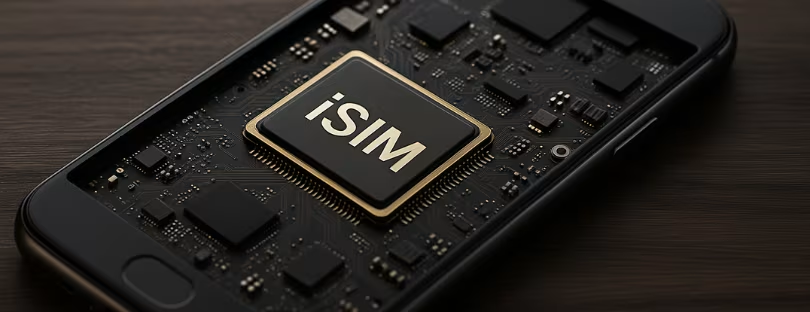
What iSIM Brings That eSIM Doesn’t
Let’s be honest: keeping up with mobile tech buzzwords isn’t easy. Just when we got used to “eSIM,” here comes a new acronym — iSIM, or integrated SIM. Officially, it’s known as iUICC, which stands for integrated Universal Integrated Circuit Card. A bit of a mouthful, right?
But don’t worry. This isn’t another confusing tech trend that fades in a few months. iSIM is the natural evolution of SIM technology, and it’s something worth paying attention to—especially if you care about faster devices, more secure connectivity, and seamless roaming (and let’s face it, if you’re here, you probably do).
Let’s break it down together — minus the jargon, plus some real-world relevance.
First, A Quick Recap: From SIM to eSIM to iSIM
Before diving into iSIM, let’s take a short walk down SIM memory lane:
- Physical SIM: The good old plastic card you pop into your phone. It holds your mobile subscriber info and lets your device connect to the network.
- eSIM (Embedded SIM): Instead of a removable card, eSIMs are embedded into your device. You download your mobile plan digitally, which is great for travelers and anyone who hates fiddling with SIM trays.
- iSIM (integrated SIM): This takes things even further. Instead of having a separate chip (like eSIM), the SIM functionality is now integrated directly into your phone’s main processor — the same one that powers everything from your camera to your operating system.
No more separate hardware. Just one tightly integrated system. That’s iSIM.
So… Why Is iSIM a Big Deal?
1. It Saves Space
Let’s start with something very practical. Every millimeter inside a phone or IoT device matters. By embedding the SIM into the processor, manufacturers can ditch the SIM card slot altogether and save that precious real estate.
That space can then be used for bigger batteries, better cameras, or more advanced sensors — things we actually care about as users.
2. Security Gets an Upgrade
Security is a huge concern, especially when we’re using our phones to pay for stuff, verify our identities, and store sensitive info. iSIM is designed to be more secure because it’s hardwired into the processor. That makes it much harder to tamper with or physically hack.
Mobile operators also love iSIM for this reason — it gives them stronger tools for remote provisioning and authentication.
3. Better for IoT Devices
IoT (Internet of Things) devices — like smart meters, connected cars, wearables — are often compact, scattered in hard-to-reach places, and expected to work for years without someone opening them up.
iSIM is ideal here because:
- There’s no need for physical SIM slots.
- It allows remote management of network profiles.
- It’s energy-efficient, which is crucial for battery-powered devices.
So while iSIM might not sound exciting at first glance, it could be the invisible tech that powers your future smart home or autonomous car.
What About for Travelers and Regular Smartphone Users?
You might be wondering, “Okay, but what’s in it for me if I just want a better phone and hassle-free roaming?”
Good question.
Here’s how iSIM benefits real users:
- Instant Network Switching: Like eSIM, iSIM supports downloading profiles remotely. Imagine landing in a new country and switching to a local network in seconds—no swapping cards, no local SIM booths, no stress.
- More Affordable Devices: Removing the need for SIM card slots can make manufacturing a bit cheaper. That could (eventually) mean cheaper phones, especially at the entry level.
- More Durable Phones: With no SIM trays or moving parts, devices can be more waterproof, dust-resistant, and durable. This matters a lot if you’re always on the move or using your phone outdoors.
- Faster Devices: Since the SIM is part of the main processor, communication between hardware components can be faster. This can mean quicker connectivity, shorter startup times, and smoother performance.
So even though it sounds technical, iSIM could actually make your life more convenient — especially if you’re a frequent traveler or use multiple mobile operators.
What’s the Difference Between eSIM and iSIM?
Let’s clarify, because the two can seem similar at first.
| Feature | eSIM | iSIM (iUICC) |
|---|---|---|
| Where is it? | Separate chip in the device | Integrated into the processor |
| Removable? | No | No |
| Space-saving? | Yes | Even more so |
| Security | High | Higher |
| Remote setup | Yes | Yes |
| Ideal for | Phones, tablets | Phones, wearables, IoT |
So, iSIM isn’t replacing eSIM right away—but it’s the next logical step. Think of it like this: eSIM walked so iSIM could run.
Which Devices Already Support iSIM?
As of now, iSIM is still in early stages, but some manufacturers have started adding support:
- Qualcomm and Thales showcased the first working iSIM demo in 2022 using a Snapdragon 8 Gen 2 chipset.
- Some Samsung Galaxy S series models and high-end Qualcomm platforms are ready to support it.
- Expect future smartphones, wearables, and smart devices to quietly adopt iSIM over the next few years.
So even if your current phone isn’t using iSIM, chances are your next one will.
What About the Mobile Operators?
Great question — because tech is only as useful as its adoption.
The good news? Many mobile operators are on board, especially those who already support eSIM. They’re building infrastructure to support Remote SIM Provisioning (RSP) for iSIM as part of their larger 5G and IoT strategies.
So the groundwork is being laid. As demand for connected devices grows (especially in industries like healthcare, automotive, logistics), iSIM will become a central piece of the puzzle.
What iSIM Brings That eSIM Doesn’t: A Quick Comparison
While eSIM was a big leap from plastic SIM cards, iSIM goes even further — by removing the need for a separate SIM component entirely. Here’s how iSIM improves on what eSIM already started:
| Feature | eSIM | iSIM |
|---|---|---|
| Location in device | Embedded chip (separate) | Integrated into the main processor (SoC) |
| Space saving | Frees up SIM slot | Eliminates SIM slot and eSIM chip |
| Security | Very secure | Even more secure — inside trusted processor zone |
| Power consumption | Efficient | More efficient (tighter integration) |
| Ideal use cases | Phones, tablets | Phones, wearables, IoT, industrial devices |
| Tamper resistance | High | Very high — no separate chip to attack |
In short, iSIM makes mobile connectivity smaller, smarter, and more secure. It’s not replacing eSIM overnight — but it’s quietly setting the stage for what comes next.
TL;DR — Should You Be Excited About iSIM?
Yes — but maybe not in the “run out and buy it now” kind of way. More like:
“Oh wow, in a year or two, this tech could quietly make my devices smaller, faster, more secure, and more connected.”
And that’s worth getting behind.
Just like how most people didn’t know what “eSIM” was a few years ago, iSIM will eventually become standard—silently powering the next generation of mobile and IoT connectivity.
So next time you hear “iSIM,” you’ll know: it’s not just another acronym. It’s the future of staying connected — baked right into your device, no tray required.










